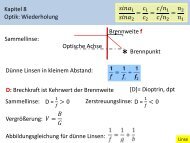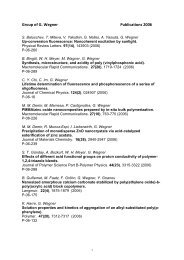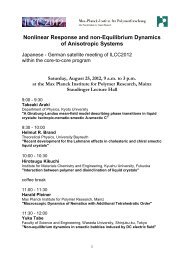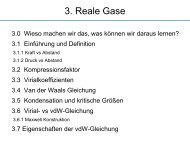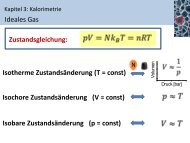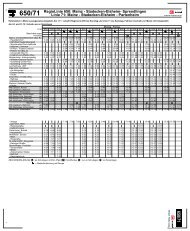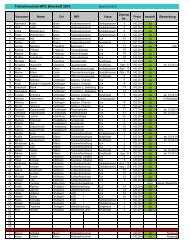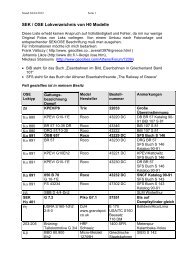Cyclic Voltammetry
Cyclic Voltammetry
Cyclic Voltammetry
You also want an ePaper? Increase the reach of your titles
YUMPU automatically turns print PDFs into web optimized ePapers that Google loves.
10 CHAPTER 1. CYCLIC VOLTAMMETRY<br />
Figure 1.8: Linear increase of the potential vs time.<br />
• The rate of the electron transfer reaction(s)<br />
• The chemical reactivity of the electroactive species<br />
• The voltage scan rate<br />
In LSV measurements the current response is plotted as a function of voltage rather than time, unlike<br />
potential step measurements.<br />
The scan begins from the left hand side of the current/voltage plot where no current flows. As the<br />
voltage is swept further to the right (to more reductive values) a current begins to flow and eventually<br />
reaches a peak before dropping. To rationalise this behaviour we need to consider the influence of voltage<br />
on the equilibrium established at the electrode surface. Here the rate of electron transfer is fast in<br />
comparsion to the voltage sweep rate. Therefore at the electrode surface an equilibrum is established<br />
identical to that predicted by thermodynamics. You may recall from equilibrium electrochemistry that<br />
the Nernst equation<br />
The exact form of the voltammogram can be rationalised by considering the voltage and mass transport<br />
effects. As the voltage is initially swept from V1 the equilibrium at the surface begins to alter and the<br />
current begins to flow. The current rises as the voltage is swept further from its initial value as the<br />
equilibrium position is shifted further to the right hand side, thus converting more reactant. The peak<br />
occurs, since at some point the diffusion layer has grown sufficiently above the electrode so that the flux<br />
of reactant to the electrode is not fast enough to satisfy that required by the Nernst equation. In this<br />
situation the curent begins to drop just as it did in the potential step measurements. In fact the drop in<br />
current follows the same behaviour as that predicted by the Cottrell equation.<br />
The above voltammogram was recorded at a single scan rate. If the scan rate is altered the current<br />
response also changes. The figure 1.8 shows a series of linear sweep voltammograms recorded at different<br />
scan rates. Each curve has the same form but it is apparent that the total current increases with increasing<br />
scan rate. This again can be rationalised by considering the size of the diffusion layer and the time taken<br />
to record the scan. Clearly the linear sweep voltammogram will take longer to record as the scan rate is<br />
decreased. Therefore the size of the diffusion layer above the electrode surface will be different depending<br />
upon the voltage scan rate used. In a slow voltage scan the diffusion layer will grow much further from<br />
the electrode in comparison to a fast scan. Consequently the flux to the electrode surface is considerably<br />
smaller at slow scan rates than it is at faster rates. As the current is proportional to the flux towards the<br />
electrode the magnitude of the current will be lower at slow scan rates and higher at high rates. This<br />
highlights an important point when examining LSV (and cyclic voltammograms), although there is no<br />
time axis on the graph the voltage scan rate (and therefore the time taken to record the voltammogram)<br />
do strongly effect the behaviour seen. A final point to note from the figure is the position of the current<br />
maximum, it is clear that the peak occurs at the same voltage and this is a characteristic of electrode<br />
reactions which have rapid electron transfer kinetics. These rapid processes are often referred to as<br />
reversible electron transfer reactions.<br />
This leaves the question as to what would happen if the electron transfer processes were ‘slow’ (relative<br />
to the voltage scan rate). For these cases the reactions are referred to as quasi-reversible or irreversible



